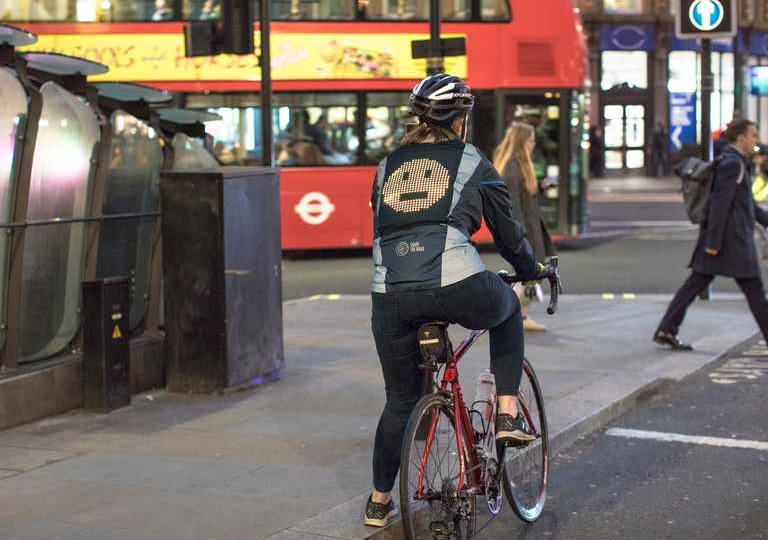Biking in cities can be thrilling, but it can also be perilous. Every year lakhs of cyclists are murdered by motorists and this percentage keeps on increasing with every coming year.
Cyclists use fluorescent clothes and flashing lights and blinking lights to make themselves more visible to two people and traffic yet it never seems to be enough.
As a solution to this huge problem for cyclists, Ford has come up with a new solution: an emoji jacket. The automaker’s European division produced a cycling jacket with an LED display on the back that lights up with various emotions to indicate a cyclist’s emotions as a part of its ‘Share the Road’ campaign to increase cycling safety.
It has different emojis for different moods a 🙂 for happy cyclists a 🙁 for a less happy one and this list goes on. There are additional directional marks for when a cyclist wants to make a turn and there is also a hazard symbol to indicate when they are experiencing a flat tire.
All this is not the first time that a company has come up to promote a jacket using conversation media; this concept isn’t wholly original. Bike helmets with turn signals and brake lights are available from other brands such as Lumos.
Last week the pitch entrepreneur Intentful Motion Pictures pitched its bike lights which integrate into your existing bicycle and serve as brake lights and turn signals.
So it’s talking about the good things this idea has merit. Emojis as Ford points out in its press release can transmit a lot of information in a tiny amount of area.
Neil Cohn, a Tilburg University professor, said in his statement that “This jacket can allow ideas to communicate their feelings and provides a crucial emotional link between them and other road users.”
This is such great thought and a nice sentiment. But why doesn’t Ford let us know how much this jacket would cost or how we can get one? The answer to this is never because most likely this jacket is never going to be manufactured and it is only the part of ‘Share the Road’ a massive, coordinated public relations operation by Ford.
On the surface, ‘Share the Road’ appears to be a emoji campaign in which Ford proclaims that ‘roads are for sharing.’ It breaks down ‘how you can do your part’ including a virtual reality experience of riding a bike in congested traffic and even addresses some real-world adjustments the corporation is doing.
‘Vehicle sharing and e-bikes for commuters and commercial users, for example, are part of the Ford Smart Mobility Plan. Ford pass bike rentals and crowd-sourced Chariot shuttle vans are also a part of the plan.
The proposal however and at that one webpage. Where are the improvements in the public-private infrastructure? Where has long-term planning gone? And where can I get this jacket?
You can’t, according to the scores of media pieces covering the product release that is in lockstep with Ford’s message. And it is a pretty solid signal that Ford’s goal with this campaign has already been accomplished: to make it appear as if it is attempting to make cycling safer while putting forth the bare minimum of effort.
WOULD THIS IDEA ACTUALLY MAKE A DIFFERENCE?
Ford already understands what it can do to make cycling safe for cyclists. “Taking a fresh look at transportation and discovering smarter ways to make a major difference, especially in large areas with poor air quality and increased congestion,” it says in its pitch.
Emoji marketing has become a fundamental part of how we use language in today’s time in particular and is a speedy way of communication. While most of us think that emojis can solely be used for conveying facial expressions, humor, or sarcasm. They can also be an integral part to express oneself easily and quickly.
But as we have previously stated, this message must be directed at those most likely to cause harm to drivers and any campaign based on a ‘Share the Road’ message sends the wrong message.
This is especially true after reading the news of a Texas teenager who crashed into six cyclists while ‘coal rolling- them earlier this week.
After reading everything you can conclude that this campaign has its pros and cons and it may seem different to different people. To some people, it may seem a brilliant idea but to some, it is nothing new or something not that effective. But this is something which we are going to leave to our readers. What do you guys think?
Happy reading!













